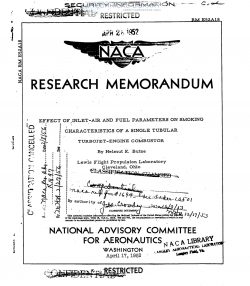naca-rm-e52a18
- Version
- 46 Downloads
- 1.32 MB File Size
- 1 File Count
- May 25, 2017 Create Date
- May 25, 2017 Last Updated
National Advisory Committee for Aeronautics, Research Memorandum - Effect of Inlet Air and Fuel Parameters on Smoking Characteristics of a Single Tubular Turbojet-Engine Combustor

An investigation was conducted to determine the effect of system-
atic variations in inlet-air and fuel parameters on the smoking charac-
teristics of a single tubular turbojet—engine combustor. For comparison
purposes, a series of tests was conducted at static sea-level conditions
over a range of engine speeds with a full-scale turboJet engine having
combustors similar to the single-tube unit investigated. The concentra-
tion of smoke in the combustion gases was determined by means of a fil-
ter technique whereby smoke particles were deposited on a special filter
paper. The optical density of the deposit as determined by a trans—
mission densitometer served as an_indication of the amount of smoke in
the exhaust gas.
The most pronounced effect on smoke was observed with increases in
inlet-air pressure which produced large increases in smoke concentra—
tion. As fuel-air ratios were increased, smoke densities increased,
passed through a mimum, and finally decreased. Increases in inlet-
air velocity reduced maximum smoke densities. The effect of inlet—air
temperature and fuel volatility on smoke densities was small. Increases
in fuel-inlet temperature increased smoke formation slightly. In the
full-scale engine, smoke density increased with increasing engine speed
and with decreasing exhaust-nozzle area.
The results obtained during this investigation suggest that carbon
is formed in the primary zone of a turbojet combustor and is subse-
quently partly burned in passing through the flame zone, the unburned
portion emerging as smoke. Thus, these factors that either tend to
reduce carbon formation in the primary zone, such as decreases in pres-
sure and in primary zone fuel-air ratios, or tend to bring about
increased burning of smoke in the flame zone such as increased flame
length and combustion—gas temperature, will reduce the concentration of
smoke in the exhaust gases.
The formation of carbon in.turboJet combustors presents a number of
major engine operational problems. Previous investigations (refer-
ences l and 2) and operational experience have shown that carbon deposi-
tion on walls, fuelrinJection nozzles, and ignitors affects combustion
efficiency, altitude operational limit, and ignition characteristics of
the combustor. Also, the distorted air-flow and fuel-flow patterns
which result from carbon deposits frequently cause warping and burning
of the combustor liners. Carbon dispersed in the gas stream as smoke
does not, in general, impair combustor-performance characteristics,
but is objectionable in military operations where smoke trails
remaining in the wake of Jetfipowered aircraft may be easily detected
by the enemy.
| File | Action |
|---|---|
| naca-rm-e52a18 Effect of Inlet Air and Fuel Parameters on Smoking Characteristics of a Single Tubular Turbojet-Engine Combustor.pdf | Download |

Comment On This Post